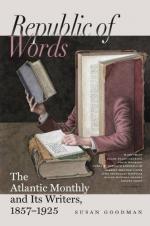Harps, however, would be of little value, were there no bards to sing and no minstrels to play. Walter Scott was decidedly wrong, when, speaking of his minstrel, he says,—
“The last of all the bards was he.”
Nonsense! I saw at least fifty in that procession,—regular, legitimate bards,—each one having a bardic bald pate, a long white bardic beard, flowing bardic robes, bardic sandals, a bardic harp in his hand, and an ancient bardic name. There was Bard Alaw, Bard Llewellyn, Bard Ap-Tudor, Bard Llyyddmunnddggynn, (pronounce it, if you can, Reader,—I can’t,) and I am afraid to say how many more, in face of the high poetical authority I have just cited and refuted. Talk of the age of poetry having passed away, when three-score and ten bards can be seen at one time in a little Welsh town! These men of genius were headed by Bard Alaw, whose unpoetical name, I almost hesitate to write it, was Williams,—Taliesin Williams,—the Welsh given name alone redeeming it from obscurity. I found, too, to my disenchantment, that all the other bards were Joneses and Morgans, Pryces and Robertses, when they were met in everyday life, before and after these festivals; and that they kept shops, and carried on mechanical trades. Only fancy Bard Ap-Tudor shaving you, or Bard Llyynnssllumpllyynn measuring you for a new pair of trowsers!
After the bards and minstrels came the gentry of the county, the clergy, and distinguished strangers, before and behind whom banners floated and flags streamed. On many of these banners were fancy portraits of Saint David, the Patron Saint of Wales, always with a harp in his hand. But the Saint must have had a singularly varied expression of countenance, or else his portrait-painters must have been mere block-heads, for no two of their productions were alike. I saw smiling Davids, frowning Davids, mild Davids, and ferocious Davids,—Davids with oblique eyes, red noses, and cavernous mouths,—and Davids as blind as bats, or with great goggle-orbs, aquiline nasal organs, blue at the tips, and lips made for a lisp. One David had a brown Welsh wig on his head, and was anachronistically attired in a snuff-colored coat, black small-clothes, gray, coarse, worsted stockings, high-low boots, with buckles, and he wore on his head a three-cornered hat, and used




